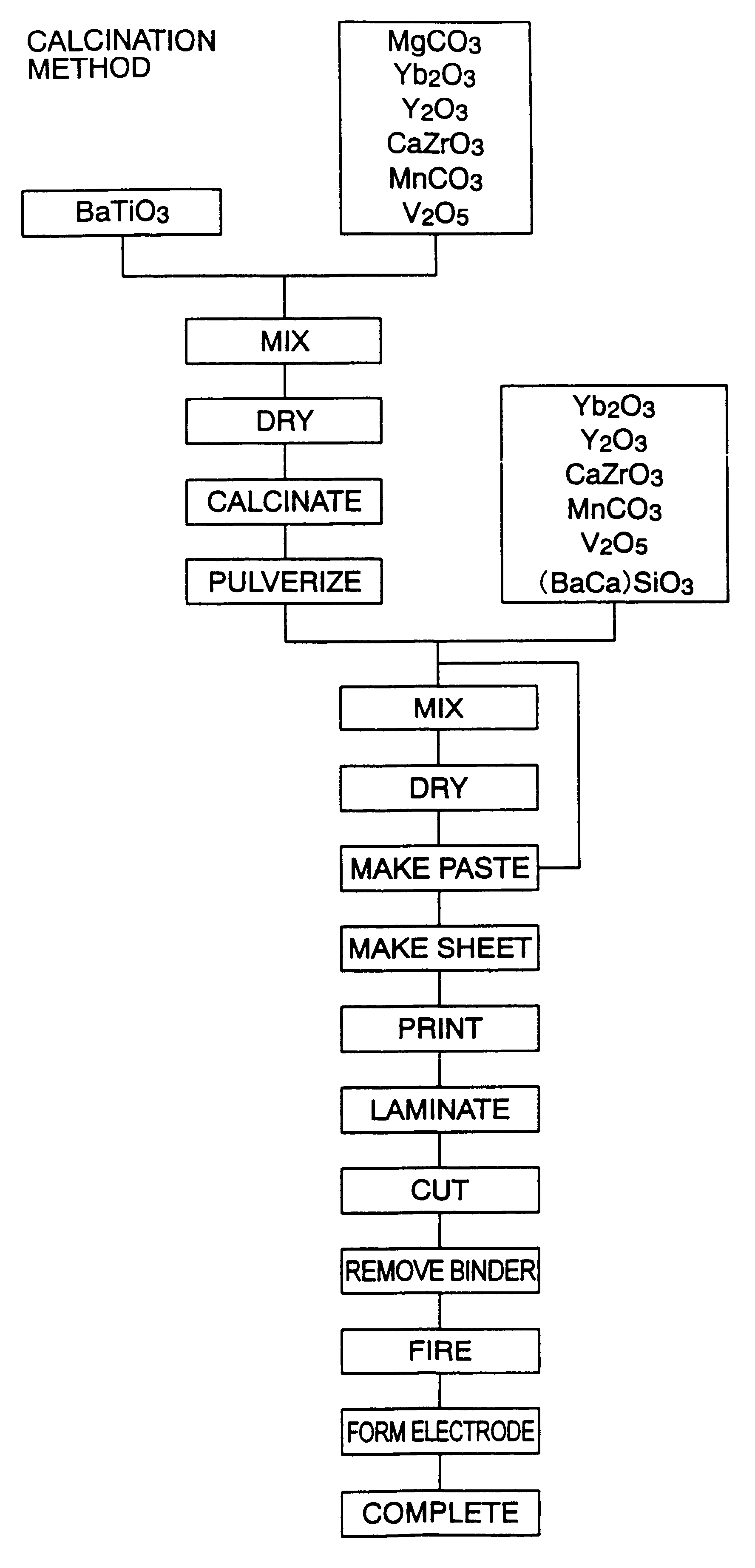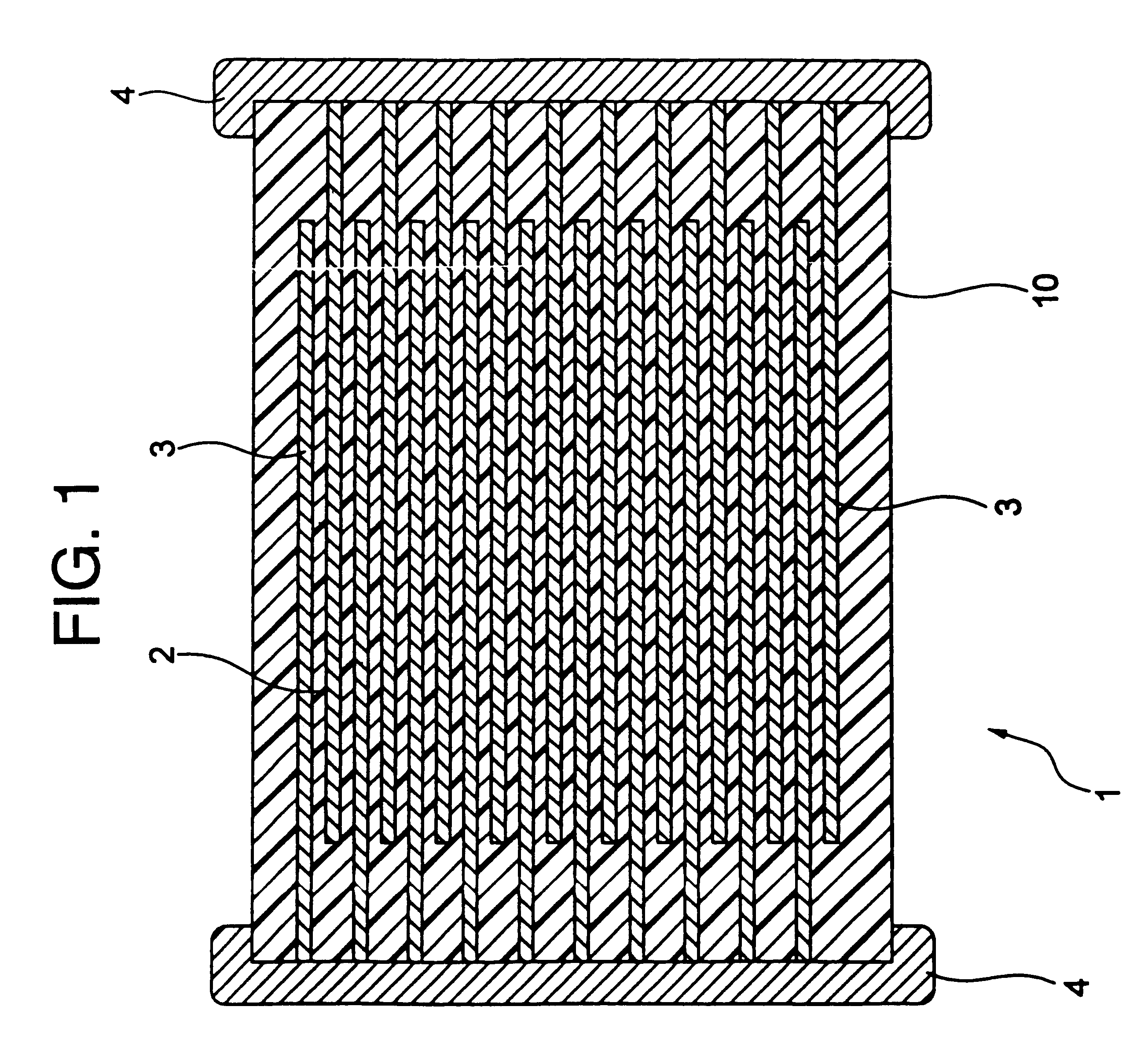Manufacture method of dielectric ceramic composition
a technology of dielectric ceramic and manufacturing method, which is applied in the direction of fixed capacitor dielectric, fixed capacitor details, fixed capacitors, etc., can solve the problems of substantially impossible to produce capacitors with large capacitances, the x7r characteristic of conventional dielectric ceramic compositions is not able to cope with electronic devices with more severe environmental conditions, and achieve excellent high temperature accelerated lifetime characteristics and high permittivity and insulation resistance.
- Summary
- Abstract
- Description
- Claims
- Application Information
AI Technical Summary
Benefits of technology
Problems solved by technology
Method used
Image
Examples
example 1
Samples of multilayer ceramic capacitors were produced by the procedure described below.
First, the following pastes were prepared.
Dielectric Layer Paste
First, ingredients of the main component and ingredients of the subcomponents having a grain diameter of 0.1 to 1 .mu.m were prepared. Carbonates were used for the ingredients of MgO and MnO, and oxides were used for other ingredients. Also, (Ba.sub.0.5 Ca.sub.0.4) SiO.sub.3 was used for an ingredient of a second subcomponent. Note that (Ba.sub.0.5 Ca.sub.0.4) SiO.sub.3 was produced by performing wet mixing by a ball-mill on BaCO.sub.3, CaCO.sub.3 and SiO.sub.2 for 16 hours, drying the result, then firing at 1150.degree. C. in the air and further performing wet pulverlizing by a ball-mill for 100 hours.
At first, pre-calcination powder was prepared by mixing BaTiO.sub.3 as the main component and MgCO.sub.3 as a first subcomponent and drying the result. As shown in Table 1, the pre-calcination powder contained 0.9 mole of MgCO.sub.3 wi...
example 2
Pre-calcination powder was prepared by mixing BaTiO.sub.3 as a main component, MgCO.sub.3 as an ingredient of a first subcomponent and Y.sub.2 O.sub.3 as a fifth subcomponent and drying them. As shown in Table 1, the pre-calcination powder contained 0.9 mole of MgCO.sub.3 and 0.5 mole of Y.sub.2 O.sub.3 with respect to 100 moles of BaTiO.sub.3. When investigating the molar ratio of a specific component (Ba+Mg+Ca+Sr) / (Ti+Yb+Y) in the pre-calcination powder, it was 0.999 as shown in Table 1. The molar ratio of (Ba+Yb+Y) / (Ti+Mg+Ca+Sr) was found to be 1.001 as shown in Table 1.
Next, the pre-calcination powder was calcined to prepare cylinder-shaped samples and samples of capacitors in the same way as in the example 1 except that the calcined powder was added 3.0 moles of (Ba.sub.0.6 Ca.sub.0.4)SiO.sub.3, 0.374 mole of MnCO.sub.3, 0.1 mole of V.sub.2 O.sub.5, 2.1 moles of Yb.sub.2 O.sub.3 and 1.5 moles of Y.sub.2 O.sub.3 as shown in Table 2, and the same tests as in the example 1 were co...
example 3
Pre-calcination powder was prepared by mixing BaTiO.sub.3 as a main component, MgCO.sub.3 as an ingredient of a first subcomponent and Yb.sub.2 O.sub.3 as a fourth subcomponent and drying them. As shown in Table 1, the pre-calcination powder contained 0.9 mole of MgCO.sub.3 and 0.5 mole of Yb.sub.2 O.sub.3 with respect to 100 moles of BaTiO.sub.3. When investigating the molar ratio of a specific component (Ba+Mg+Ca+Sr) / (Ti+Yb+Y) in the pre-calcination powder, it was 0.999 as shown in Table 1. The molar ratio of (Ba+Yb+Y) / (Ti+Mg+Ca+Sr) was found to be 1.001 as shown in Table 1.
Next, the pre-calcination powder was calcined to prepare cylinder-shaped samples and samples of capacitors in the same way as in the example 1 except that the calcined powder was added 3.0 moles of (Ba.sub.0.6 Ca.sub.0.4)SiO.sub.3, 0.374 mole of MnCO.sub.3, 0.1 mole of V.sub.2 O.sub.5, 1.6 moles of Yb.sub.2 O.sub.3 and 2.0 moles of Y.sub.2 O.sub.3 as shown in Table 2, and the same tests as in the example 1 were...
PUM
| Property | Measurement | Unit |
|---|---|---|
| Substance count | aaaaa | aaaaa |
| Substance count | aaaaa | aaaaa |
| Substance count | aaaaa | aaaaa |
Abstract
Description
Claims
Application Information
 Login to View More
Login to View More - R&D
- Intellectual Property
- Life Sciences
- Materials
- Tech Scout
- Unparalleled Data Quality
- Higher Quality Content
- 60% Fewer Hallucinations
Browse by: Latest US Patents, China's latest patents, Technical Efficacy Thesaurus, Application Domain, Technology Topic, Popular Technical Reports.
© 2025 PatSnap. All rights reserved.Legal|Privacy policy|Modern Slavery Act Transparency Statement|Sitemap|About US| Contact US: help@patsnap.com



